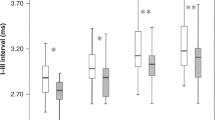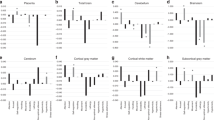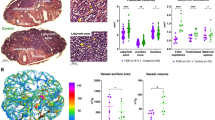Abstract
Background
Adverse neurodevelopmental outcomes and MRI alterations are reported in infants born after fetal growth restriction (FGR). This study evaluates the additional role of FGR over prematurity in determining brain impairment.
Methods
Retrospective observational study comparing 48 FGR and 36 appropriate for gestational age infants born between 26 and 32 weeks’ gestation who underwent a cerebral MRI at term equivalent age. Exclusion criteria were twins, congenital anomalies, and findings of overt brain lesions. Main outcomes were total maturation score (TMS) and cerebral areas independently measured by two neuro-radiologists and Griffiths or Bayley scale III scores at median age of 2 years.
Results
TMS was not significantly different between the groups. Inner calvarium and parenchyma’s areas were significantly smaller in FGR cases. There were no significant differences in the average quotient scores. A positive correlation between parenchyma area and cognitive score was found (r = 0.372, p = 0.0078) and confirmed after adjusting for sex, gestational age, and birth weight (p = 0.0014). Among FGR, the subgroup with umbilical arterial Doppler velocimetry alterations had significantly worse gross motor scores (p = 0.005).
Conclusions
FGR plays additional role over prematurity in determining brain impairment. An early structural dimensional MRI evaluation may identify infants who are at higher risk.
Impact
-
Fetal growth-restricted infants showed smaller cerebral parenchymal areas than preterm controls.
-
There is a positive correlation between the parenchyma area and the cognitive score.
-
These results highlight the already known link between structure and function and add importance to the role of a structural dimensional MRI evaluation even in the absence of overt brain lesions.
Similar content being viewed by others
Log in or create a free account to read this content
Gain free access to this article, as well as selected content from this journal and more on nature.com
or
References
Gordijin, S. J. et al. Consensus definition of fetal growth restriction: a Delphi procedure. Ultrasound Obstet. Gynecol. 48, 333–339 (2016).
Cetin, I. & Alvino, G. Intrauterine growth restriction: implications for placental metabolism and transport. A review. Placenta 30, 77–82 (2009).
Cetin, I. et al. Fetal oxygen and glucose consumption in human pregnancy complicated by fetal growth restriction. Hypertension 75, 748–754 (2020).
Ferrazzi, E. et al. Temporal sequence of abnormal Doppler changes in the peripheral and central circulatory systems of the severely growth-restricted fetus. Ultrasound Obstet. Gynecol. 19, 140–146 (2002).
Pardi, G. et al. Diagnostic value of blood sampling in fetuses with growth retardation. N. Engl. J. Med. 328, 692–696 (1993).
Figueras, F. & Gratacos, E. Update on the diagnosis and classification of fetal growth restriction and proposal of a stage-based management protocol. Fetal Diagn. Ther. 36, 86–98 (2014).
Figueras, F. et al. Neurobehavioral outcomes in preterm, growth-restricted infants with and without prenatal advanced signs of brain-sparing. Ultrasound Obstet. Gynecol. 38, 288–294 (2011).
Scherjon, S., Briet, J., Oosting, H. & Kok, J. The discrepancy between maturation of visual-evoked potentials and cognitive outcome at five years in very preterm infants with and without hemodynamic sign of fetal brain sparing. Pediatrics 105, 385–391 (2000).
Baschat, A. Neurodevelopment following fetal growth restriction and its relationship with antepartum parameters of placental dysfunction. Ultrasound Obstet. Gynecol. 37, 501–514 (2011).
Bashat, A. A., Viscardi, R. M., Hussey-Gardner, B., Hashmi, N. & Harman, C. Infant neurodevelopment following fetal growth restriction: relationship with antepartum surveillance parameters. Ultrasound Obstet. Gynecol. 33, 44–50 (2009).
Morsing, E., Asard, M., Ley, D., Stjernqvist, K. & Marsàl, K. Cognitive function after intrauterine growth restriction and very preterm birth. Pediatrics 127, e874–e882 (2011).
Gale, C. R., O’Callaghan, F. J., Bredow, M. & Martyn, C. N. The influence of head growth in fetal life, infancy, and childhood on intelligence at the ages of 4 and 8 years. Pediatrics 118, 1486–1492 (2006).
Malhotra, A. et al. Detection and assessment of brain injury in the growth-restricted fetus and neonate. Pediatr. Res. 82, 184–193 (2017).
Tolsa, C. B. et al. Early alteration of structural and functional brain development in premature infants born with intrauterine growth restriction. Pediatr. Res. 56, 132–138 (2004).
Lodygensky, G. A. et al. Intrauterine growth restriction affects the preterm infant’s hippocampus. Pediatr. Res. 63, 438–443 (2008).
Padilla, N. et al. Differential effects of intrauterine growth restriction on brain structure and development in preterm infants: a magnetic resonance imaging study. Brain Res. 1382, 98–108 (2011).
Padilla, N. et al. Differential vulnerability of gray matter and white matter to intrauterine growth restriction in preterm infants at 12 months corrected age. Brain Res. 1545, 1–11 (2014).
Dubois, J. et al. Primary cortical folding in the human newborn: an early marker of later functional development. Brain 131, 2028–2041 (2008).
Peterson, B. S. et al. Regional brain volumes and their later neurodevelopmental correlates in term and preterm infants. Pediatrics 111, 939–948 (2003).
Batalle, D. et al. Altered small-world topology of structural brain networks in infants with intrauterine growth restriction and its association with later neurodevelopmental outcome. Neuroimage 60, 1352–1366 (2012).
Fischi-Gomez, E. et al. Structural brain connectivity in school-age preterm infants provides evidence for impaired networks relevant for higher order cognitive skills and social cognition. Cereb. Cortex 25, 2793–2805 (2014).
Kidokoro, H., Neil, J. J. & Inder, T. E. New MR Imaging assessment tool to define brain abnormalities in very preterm infants at term. Am. J. Neuroradiol. 34, 2208–2214 (2013).
Childs, A. M. et al. Cerebral maturation in premature infants: quantitative assessment using MR imaging. Am. J. Neuroradiol. 22, 1577–1582 (2001).
Ramenghi, L. A. et al. Magnetic resonance imaging assessment of brain maturation in preterm neonates with punctate white matter lesions. Neuroradiology 49, 161–167 (2007).
Ramenghi, L. A. et al. Cerebral maturation in IUGR and appropriate for gestational age preterm babies. Reprod. Sci. 18, 469–475 (2011).
Griffiths, R. The Abilities of Young Children (The Test Agency, High Wycombe, 1970).
Bayley, N. Bayley Scales of Infant and Toddler Development (The Psychological Corporation, San Antonio, TX, 2006).
Milne, S. L. et al. Alternate scoring of the Bayley-III improves prediction of performance on Griffiths Mental Development Scales before school entry in preschoolers with developmental concerns. Child. Care Health Dev. 41, 203–212 (2014).
Bruno, C. J. et al. MRI differences associated with intrauterine growth restriction in preterm infants. Neonatology 111, 317–323 (2017).
Ganzevoort, W. et al. Comparative analysis of the 2-year outcomes in the GRIT and TRUFFLE trials. Ultrasound Obstet. Gynecol. 55, 68–74 (2020).
Levine, T. A. et al. Early childhood neurodevelopment after intrauterine growth restriction: a systematic review. Pediatrics 135, 126–141 (2015).
Padilla, N. et al. Twelve-month neurodevelopmental outcome in preterm infants with and without intrauterine growth restriction. Acta Paediatr. 99, 1498–1503 (2010).
Procianoy, R. S., Koch, M. S. & Silveira, R. C. Neurodevelopmental outcome of appropriate and small for gestational age very low birth weight infants. J. Child Neurol. 24, 788–79 (2009).
Acknowledgements
We would like to thank all the hospital staff and the patients who agreed to participate making this study possible. No financial support was received for this study.
Author information
Authors and Affiliations
Contributions
G.B., E.C., F.M.C., E.T., M.B., M.D.S., C.C., and E.L. gave substantial contributions to conception and design, acquisition of data, and analysis and interpretation of data. G.B., I.C., A.R., G.L., and B.S. contributed to draft the article and to revise it critically for important intellectual content. I.C. gave final approval of the version to be published.
Corresponding author
Ethics declarations
Competing interests
The authors declare no competing interests.
Statement of patient consent
Appropriate patient consent was obtained for the publication of this manuscript by G.B.
Additional information
Publisher’s note Springer Nature remains neutral with regard to jurisdictional claims in published maps and institutional affiliations.
Supplementary information
Rights and permissions
About this article
Cite this article
Brembilla, G., Righini, A., Scelsa, B. et al. Neuroimaging and neurodevelopmental outcome after early fetal growth restriction: NEUROPROJECT—FGR. Pediatr Res 90, 869–875 (2021). https://doi.org/10.1038/s41390-020-01333-1
Received:
Revised:
Accepted:
Published:
Issue date:
DOI: https://doi.org/10.1038/s41390-020-01333-1
This article is cited by
-
Early Fetal Growth Restriction with or Without Hypertensive Disorders: a Clinical Overview
Reproductive Sciences (2024)



